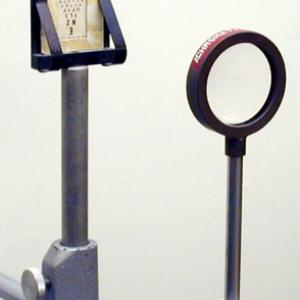College of Liberal Arts & Sciences
6A70.10 - Microscopes
The microscope is set up as indicated with the +20 lens at the end of the track near the camera and the +18 at the end near the eye chart slide. Use the camera in place of the human eye. The camera should be focused at infinity.
An interesting possiblilty is to buy a small microscope unit that can be attached to a smartphone. This assembly will show the microscopic world with great flexibility.
- James Lincoln, "Ten Annoying Experiments to do at Dinnertime", TPT, Vol. 63, #2, Feb. 2025, p. 136.
- Timo Hergemöller and Daniel Laumann, "Smartphone Magnification Attachment: Microscope or Magnifying Glass", TPT, Vol. 55, #6, Sept. 2017, p. 361.
- A. J. Cox and Alan J. DeWeerd, "The Image Between the Lenses: Activities with a Telescope and a Microscope", TPT, Vol. 41, #3, Mar. 2003, p. 176.
- Gorazd Planinsic, "Water-Drop Projector", TPT, Vol. 39, #2, Feb. 2001, p. 76.
- Mark L. Biermann and Lois A. A. Biermann, "When the f/♯ is not the f/♯", TPT, Vol. 34, #5, May 1996, p. 312.
- Kenneth N. Taylor, "Measuring Focal Lengths and Principal Planes of Complex Lens", TPT, Vol. 25, #8, Nov. 1987, p. 484.
- Wayne O. Williams, "Glass Tubing Microscope", TPT, Vol. 17, #3, Mar. 1979, p. 204, also A Potpourri of Physics Teaching Ideas - Tricks of the Trade, p. 350.
- Robert P. Lanni, "Letters to the Editor: Optics Experiments by Armstrong", TPT, Vol. 5, #2, Feb. 1967, p. 84.
- H. L. Armstrong, "Apparatus for Teaching Physics: An Experiment on Optical Devices", TPT, Vol. 4, #7, Oct. 1966, p. 323.
- Thomas B. Greenslade, Jr., "Culpepper Microscope", AJP, Vol. 90, #12, Dec. 2022, p. 902.
- J. Higbie, "Microscope Resolution", AJP, Vol. 49, #1, Jan. 1981, p. 40.
- Euan McLeod and Aydogan Ozcan, "Microscopy without Lenses", Physics Today, Vol. 70, #9, Sept. 2017, p. 50.
- Andrew Resnick, "Bubbles in Contrast", Physics Today, Vol. 67, #7, July 2014, p. 68.
- Amanda Green, "A Brief History of the Microscope", Popular Mechanics, Vol. 190, #3, Mar. 2013 p. 112.
- Daniel Engber, "Which is More Powerful: A Giant Microscope or a Giant Telescope", Popular Science, Vol. 288, #1, Jan/Feb 2016, p. 100.
- Sophie Bushwick, "An Origami Microscope for Less Than a Dollar", Popular Science, Vol. 286, #9, Sept. 2014, p. 72.
- Shawn Carlson, "The Amateur Scientist: Home Movies of an Invisible World", Scientific American, Vol. 279, #4, Oct. 1998, p. 118.
- Martin C. Sagendorf, "A Closer Look", Physics Demonstration Apparatus, 2009. p. 122.
- 50 Fun Experiments for the Mad Scientist in You, "Bonus: Microphoto", National Geographic Kids, p. 37.
- Janice VanCleave, "Determine How the Focal Length of a Magnifying Lens Affects Its Magnifying Power", Super Science Challenges, p. 19.
- "Helpful Devices", The Boy Scientist, p. 9.
- Harvard Instructional Physics Labs, "Lab 6: Microscopy", www.fas.harvard.edu/~scphys
- C. Harvey Palmer, "Experiment A16: The Refracting Telescope", Optics - Experiments and Demonstrations, John Hopkins Press, 1962.
- T. D. Rossing and C. J. Chiaverina, "4.10, Telescopes and Microscopes", Light Science, Physics and Visual Arts, p. 95.
- Curt Suplee, "Inner Vision", Everyday Science Explained, National Geographic, p. 112 - 113.
- "Waterdrop Microscope", Laser Classroom.
- Simon Quellen Field, "Photography Through a Microscope", Sci-Toys.com, https://sci-toys.com/scitoys/scitoys/biology/micro.html#micro_photography.
- Sara Stein, "Magnifications", The Science Book, p. 193.
- Prof. Robert Griffith, "Home-Made Microscope", Boys' Useful Pastimes, p. 90.
- Joseph Frick, "#183 - The Compound Microscope", Physical Technics: Or Practical Instructions for Making Experiments in Physics and the Construction of Physical Apparatus with the Most Limmited Means, p. 211.
- "Achromatic Microscopes", Pike's Illustrated Catalogue of Scientific & Medical Instruments, 1984, p. 353.
- The Queen Catalogues Vol. I, Catalogue of Ophthalmological Instruments, Optical Principles, p. 16.
- "AI-Driven X-Ray Analysis Discovers Nanostructures", Microscopy and Analysis, #183, Jan. 2023, p. 5.
- "Foldscope: A truly frugal microscope", Microscopy and Analysis, #183, Jan. 2023, p. 9.
Disclaimer: These demonstrations are provided only for illustrative use by persons affiliated with The University of Iowa and only under the direction of a trained instructor or physicist. The University of Iowa is not responsible for demonstrations performed by those using their own equipment or who choose to use this reference material for their own purpose. The demonstrations included here are within the public domain and can be found in materials contained in libraries, bookstores, and through electronic sources. Performing all or any portion of any of these demonstrations, with or without revisions not depicted here entails inherent risks. These risks include, without limitation, bodily injury (and possibly death), including risks to health that may be temporary or permanent and that may exacerbate a pre-existing medical condition; and property loss or damage. Anyone performing any part of these demonstrations, even with revisions, knowingly and voluntarily assumes all risks associated with them.

